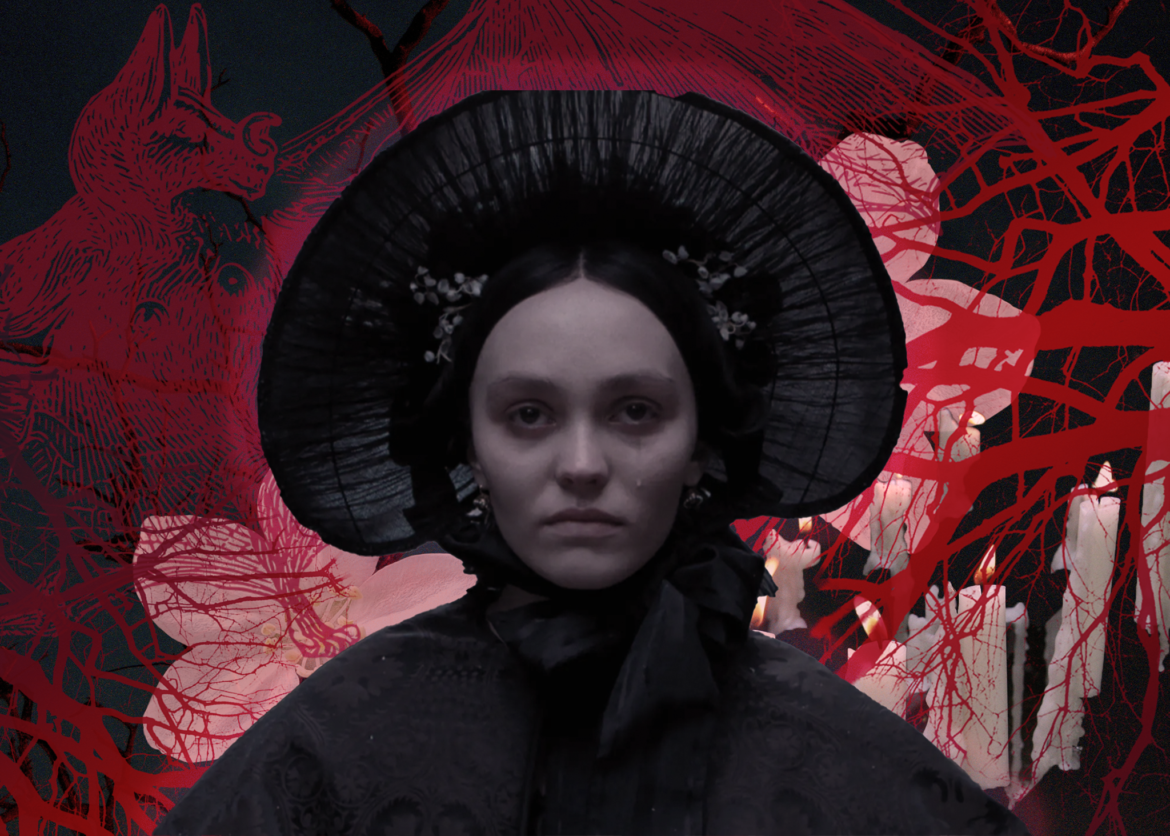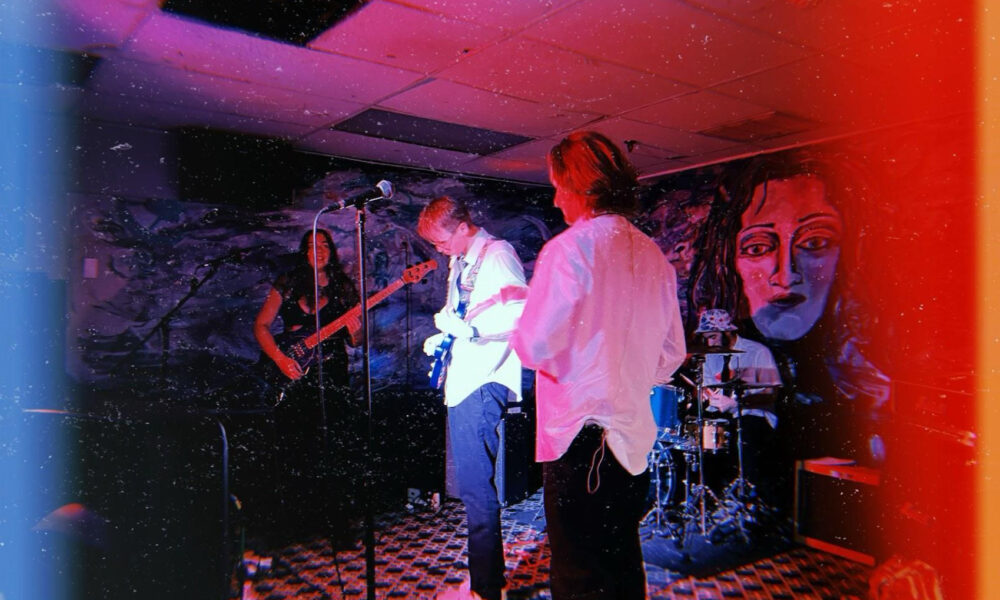Graphic by Annabelle Gilman
On Christmas Day, Robert Eggers released his adaptation of Nosferatu in theaters – fittingly, as it’s a true gift to the silver screen. My adoration of Eggers’ film, which is a rendition of the 1922 film by F.W. Murnau led me to see the modernized take twice in theaters. During the drive-home debriefs, the conversations veered in separate directions, which partly reflected each of my companions’ approaches to vampiric tales. The first person I saw the movie with grew up on vampire movies such as Dark Shadows and The Little Vampire, and accredits their gay awakening to the children’s TV show My Babysitter’s a Vampire. They argued that Eggers told a story about repressed desire. The second person, a rejector of vampire stories who entered the movie theater familiar with the titular character’s frightening appearance in a Spongebob Squarepants episode, challenged that Nosferatu was an allegory for abuse.
Conversations about the film’s message are in opposing directions online as well, with audiences debating whether Eggers’ rendition is a tale of love and desire or abuse and shame. Preconceptions of vampire stories may impact one’s immediate response to the film, but each of these debated ideas plays a pivotal role in Nosferatu. To understand the intrinsic nuance the film relies on, we must reflect on the gothic genre, where the fictional vampire was born. Eggers’ Nosferatu is multilayered, and by examining the heroine, Ellen, and her relationship to the characters and world she finds herself in, the gothic medium comes back to life in a tantalizing way.
While some cinematic vampire stories have been campy, like Francis Ford Coppola’s Bram Stoker’s Dracula, or have rivaled Neil Jordan’s Interview with the Vampire levels of histrionic, Robert Eggers’ subdued, darker storytelling in Nosferatu aligns with key themes and motifs of gothic tales. The 1922 film that Eggers revisited is a rendition of Bram Stoker’s 1897 novel Dracula, which pulls on aspects of the genre that often oppose each other: good versus evil, science versus mysticism, sin versus purity. Each of these ideas becomes more compelling when paired with its antithesis, especially in dark and gloomy settings. Gothic novels also often rely on the imagery of flowers, utilizing symbols of delicacy and femininity to allude to darkness and impending danger. In the metaphorical doom of the orchid in Charlotte Brontë’s gothic novel Jane Eyre or even the garlic flowers characters are advised to wear around their necks in Dracula, flowers can offer another layer of terror for gothic stories.
Additionally, Murnau’s adaptation centers a woman as the hero of the tale, allowing the story to follow a premise previously established by Ann Radcliffe’s original gothic romance novel, A Sicilian Romance (1790), in which a woman must confront the macabre and defeat it through her wit and grit in order to achieve happiness with her true love. A century after Murnau released his film, Eggers was tasked with creating an adaptation of an adaptation of an adaptation, which meant incorporating a new perspective that respected its many predecessors but still intrigued modern audiences. To achieve this, the themes of Eggers’ Nosferatu feed off each other to create a true vampiric tale that unfolds through the experiences of Ellen, the first character that is introduced to the audience.
Eggers begins his film with a glimpse into the catalytic action that launches the rest of the story and quickly establishes some of the gothic concepts that audiences will encounter in the film. Ellen, played by Lily-Rose Depp, possesses an otherworldly power that allows her to reach beyond the veil of humans and the supernatural, isolating her from society. This isolation leads Ellen to connect with the demonic Count Orlok, played by Bill Skarsgård. He tells Ellen that she is “not for the living” and “not for humankind” before raping her in a lilac garden and professing they are forever bound together.
The lilac often symbolizes first love and youthful innocence, and was also one of the only appropriate colors to wear after a period of mourning during the Victorian era. A garden of lilacs represents an overabundance of these ideas, yet Ellen’s first sexual encounter is not one of a blooming love but violent aggression; Orlok metaphorically kills her innocence and bestows upon her a guilt that isolates her from society even further. By juxtaposing her horrific experience with the lilac background, Eggers begins his film with the gothic tradition of opposing ideas that add more depth to his heroine. Centering Ellen and her experience in the lilac garden from the beginning encourages audiences to follow her as she experiences the aforementioned debated themes, beginning with her abuse.
Like many gothic heroines, Ellen’s internal conflicts manifest outside of herself, giving her something to fight for and against. In Nosferatu, Orlok becomes a physical manifestation of her struggles. He represents her desire for sexual liberation, which she views as demonic because of the Victorian world’s negative attitude towards female sexuality. Orlok’s behavior is construed as continually abusive to audiences, but not to Ellen, who begins to crave the seduction of the vampire in the absence of her doting husband. We see shots of Orlok’s shadow caressing her, which inspires her fits of overwhelming euphoria where she moans and shouts, “he is coming.”
Ellen’s subconscious takes over when she enters these states, allowing her repressed feelings to rise to the surface. Repression and the eventual rise and outburst of the repressed is another common aspect of the gothic genre, especially in female characters, functioning as commentary on attitudes towards feminine sexuality and expression. Ellen’s repressed sexual desires are actualized in Orlok, turning him into a tangible figure of the shame and disgust she feels for her nature. She begins wearing lilac flowers in her bonnets and garments of the same color, a subtle nod to her tempting Orlok’s memory and desires of her, and Eggers’ continued homage to a common symbol in gothic tales. Even though Ellen loves her husband, the two emotions for different beings represent a deeper struggle of hers: a man who belongs to the realm of the living, where feminine sexuality is discouraged, and a monster attached to the realm of the dead, where shame does not exist in the darkness.
Her repression is not only of a sexual nature but a psychic one, as she was able to subconsciously bury her abilities upon a marriage that now feels lost to her. Ellen’s husband, Thomas, played by Nicholas Hoult, encourages her to dismiss her premonitory nightmares of death and suffering to ease her pain, but in his absence, she is once again able to tap into her psychic power. The struggle Ellen faces recounts another trope of gothic fiction, as heroines must defeat not only a supernatural force that prevents them from their success but societal forces that similarly denounce their abilities. The two characters understand each other and feel a mutual attraction; Orlok is attracted to Ellen’s humanness paired with mystical abilities, and Ellen is attracted to the darkness of Orlok and his appreciation of her in a society that would deem her monstrous.
In the final and visually brightest scene of the movie, Ellen’s status as heroine is cemented upon her sacrifice to Orlok. She waits for him in a wedding gown with lilacs in her hair, a visual testament of their first encounter. Straying from Murnau’s film as he did in the first scene of the movie, Eggers depicts Ellen dying from blood loss after she pleads with him to drink more from her. Upon her death, Ellen is freed from her turmoil by ending the battle between her shame and lust, and in doing so, saves her true love’s – Thomas’ – life. We also see Orlok’s maggot-ridden body in full for the first time, which covers Ellen’s nakedness; Eggers visually presents Orlok’s grotesque physical appearance as the ugliness that Ellen has tied to her shame. While his corpse lays upon the maiden’s body Orlok appears vile, while Ellen appears luminous, even in death, upon the separation from her guilt. While her ending is tragic, it is also liberating as she must no longer conform to a world that disdains sexual women and would have crucified her for her abilities. As sunshine creeps into the room, Professor von Franz, played by Willem Dafoe, scatters lilacs around the maiden and beast, ending the flower motif on a mournful note of lost youth and depleted innocence. Eggers tied his tale together beautifully, transforming Ellen from a victim to victor in the gothic fashion of solemnity.
Like many of his previous films, Eggers’ Nosferatu makes us ponder a troubled character’s relationship to themself and those around them. It is not given to audiences in a neatly wrapped bow with its overlapping themes coiled with subtle motifs, but nonetheless, it is a present with entertaining content. While the movie serves as an allegory for abuse, it is also an erotic story about sexual appetites and the attractive aspects of darkness. These ideas intertwine to create Ellen’s narrative with ideas that may be equally, if not more frightening, than the cinematography, empowering Eggers to reinstate the love of the genre in contemporary audience’s hearts. He pulled on traditional gothic themes, stories and motifs to create a new version of Nosferatu that allowed him to stray from Murnau’s original ending, and Eggers’ final scene, which sees the death of Ellen, is one of the most important variations in the story that pulls from gothic tradition.
Radcliffe’s gothic stories often concluded in the same way — a woman and her true love are reunited in holy matrimony. With her heroines always returning to their male counterparts Radcliffe fictionally dramatized power imbalances in her society, allowing her books to serve as not just gothic romances but social commentaries. In Eggers’ Nosferatu, Radcliffe’s trope is followed to an extent but is dismantled by the end, freeing his heroine from the societal demands of a life that could never return to normal, if it ever was, through her death.
Ellen escapes the fate that previous gothic heroines have always been doomed to. Through Eggers’ creative liberties and Depp’s impressive performance, Nosferatu is presented to audiences with a bonnet’s nod to its gothic roots.




Comments are closed.